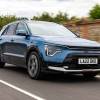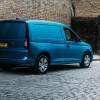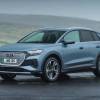
Complete peace of mind for less
• £50 off a mobile car service†
• We get to most breakdowns in 60 mins or less
• Our patrols fix 4/5 on the spot
* At least 10% of new customers paid this or less since 12/08. †Applies to new Extra or Complete cover. Restrictions apply, check mobile mechanic eligibility & availability here. Ends 18/11, 4pm.

The ID.5 makes a start on the drive to make Volkswagen EVs really desirable. Jonathan Crouch reports.
Ten Second Review
With the ID.5 mid-sized coupe-SUV, Volkswagen offers its most aspirational EV yet. It certainly has a dash more pavement presence than the ID.4 SUV it's entirely based upon: and in top GTX hot hatch form, it better showcases the brand's more potent AWD dual motor powertrain. A Volkswagen EV small boys might want to pin on their bedroom walls? Maybe not quite, but Wolfsburg is getting there
Background
The EV revolution is now in full swing, which means customers want a wider choice. And style as well as functionality from their electric vehicles. Volkswagen hopes they'll want something like this, the ID.5, the third member of the brand's growing family of full-battery-powered models.
We've already seen two other VW Group brands announce coupe versions of their mid-sized EVs. So the Skoda Enyaq iV spawned the Enyaq iV Coupe and the Audi Q4 e-tron sired the Audi Q4 Sportback e-tron. In the same way, the ID.5 is a Volkswagen ID.4 with a more rakish, swept-back roof - and a premium looking price point, starting at nearly £50,000; though partly, that's because it's only going to be offered with the larger 77kWh battery you can have in an ID.4.
Driving Experience
Every ID.5 will come with Volkswagen's larger 77kWh battery, but there are three power output choices. The most affordable models use Volkswagen's 174PS 'Pro' electric motor on the rear axle and in this form, the ID.5 can make 62mph in 10.4s en route to 99mph and can go 313 miles between charges. Fitted with the alternative uprated 204PS 'Pro Performance' motor, the 0-62mph time improves to 8.4s but the range figure stays the same. As in the ID.4 line-up, the top model is the GTX, which gains an extra motor on the front axle, so creating a 4WD system and upping power output to 299PS, though the AWD system's extra weight also slashes the driving range figure a bit - to 296 miles. An ID.5 GTX makes 62mph in 6.3s.
As in the ID.4 line-up, the top model is the GTX, which gains an extra motor on the front axle, so creating a 4WD system and upping power output to 299PS. That slashes the 0-62mph time to just 6.3s, but the AWD system's extra weight also slashes the driving range figure a bit - to 304 miles. The ID.5 GTX gets a special downforce package, consisting of a larger spoiler and diffuser, to aid high speed stability. And the chassis has been tuned to handle the extra performance, plus there's lowered suspension and upgraded brakes. And customers can order the brand's 'DCC' adaptive damping system too. The steering is Volkswagen's 'Progressive' set-up (where the ratio becomes more direct as the wheel is turned).
Design and Build
It seems you can't create a mid-sized SUV these days without also creating a coupe version of it. The ID.5 certainly has a dash more pavement presence than its ID.4 SUV stablemate; and a more slippery 0.26Cd drag factor too, though that only boosts its driving range by single mile. You'd expect the other effect of the tapering roof line to be a reduction in boot space, but actually, the 549-litre capacity figure up to the level of the parcel shelf is 6-litres more than you get in an ID.4.
Inside, Volkswagen says it's served up a slightly higher quality interior than you get in an ID.4, but the differences are difficult to spot. There's the same 6-inch digital instrument cluster and 12-inch centre dash infotainment screen as you get in that car, the latter boosted by new MEB software that adds more functions. A rocker switch attached to the steering column is used to select the three available drive modes. And all the main cabin features are accessible via advanced “Hello Volkswagen” voice control. One hi-tech feature we really like is the impressive augmented reality head-up-display, which artificially projects key information and navigation commands straight onto your view of the road ahead. At the back, there's comfortable space for a couple of adults (though it'd be a squash for three).
Market and Model
Prices start from around £50,000 and in the mainstream part of the line-up, there's a choice of 'Style', 'Tech' or 'Max' trim levels, all three offered with a choice of electric motors; either the 174PS 'Pro' unit or the 204PS 'Pro Performance' motor. At the top of the range costing around £56,000 is the GTX variant, with its 299PS output and all-wheel drive: the GTX ID.5 comes in either 'Style' or 'Max' forms. All versions of this model use the same 77kWh battery. There'll be tough competition, not only from this model's identically engineered Skoda Enyaq iV Coupe and Audi Q4 Sportback e-tron cousins but also from cars selling at this point like the Polestar 2 and the Kia EV6.
New MEB software means improvements to Volkswagen's 'Travel Assist' system, which is standard and which can do most of the driving for you at highway speeds. Standard equipment also includes the brand intelligent 'IQ.Light LED matrix' headlights and 3D LED rear tail lamps. It's a pity though, that the 'DCC' dynamic chassis control adaptive damping system is optional, even on the flagship GTX variant. Volkswagen expects a popular option to be it's 'Top Sports' front seats, which are distinguished by perforated ID logos at the tops of the backrests. All models also include the brand's 'Car2X' communication system which uses crowd-swarm data to warn you about traffic hazards ahead. Also standard is the company's neat 'ID.Light' system in the cabin, which provides visual warnings of safety system issues using the ambient lighting.
Cost of Ownership
We gave you the driving range figures in our 'Driving Experience' section, which go from 313 miles for the base variant to 296 miles for the top GTX. With this ID.5, Volkswagen's incorporating new MEB software that boosts DC maximum charging capability from 120 to 135kW. Using a rapid public charger, that means an ID.5 can charge to 80% capacity in 26 minutes, an improvement of 9 minutes. As usual with an EV, around 80% of charging will be done via programmable overnight replenishment using owners' garage wall boxes - bespoke versions of these are available through Volkswagen. This electric SUV also comes with the Volkswagen brand's high-voltage battery warranty of eight years or 100,000 miles.
Volkswagen reckons that a typical ID.5 user will save about £730 a year in operating expenses over what they'd pay to run a comparable combustion-engined model. It's not only that your energy costs will be lower: you should also make savings in insurance, road tax and the fact that no oil changes are required. Volkswagen says that its aim is to make sure that the battery pack lasts as long as the car and, sure enough, that battery pack is warrantied to have at least 70% of its usable capacity after eight years or 100,000 miles.
Summary
You have to wonder exactly how many people will be in the market for a car like this, right here, right now. And how many of the people that are will decide that they want this car, rather than its identically engineered and similar-looking VW Group cousins, the Skoda Enyaq iV Coupe and the Audi Q4 Sportback e-tron. But the Volkswagen brand remains committed to broadening its EV line-up no matter what and the ID.5 certainly provides a sleek-looking halo model for ID.3 hatch owners to aspire to.
Especially in top GTX form, where the AWD system and its extra power create a significantly more aspirational and pleasing package than is the case with the ID.4 GTX. You might really desire an ID.5 GTX, rather than merely graduate into one - and that's a crucial difference. Whether the ID.5 package as a whole is desirable enough to suit its premium price point is another question. We'll let the market answer that one.







